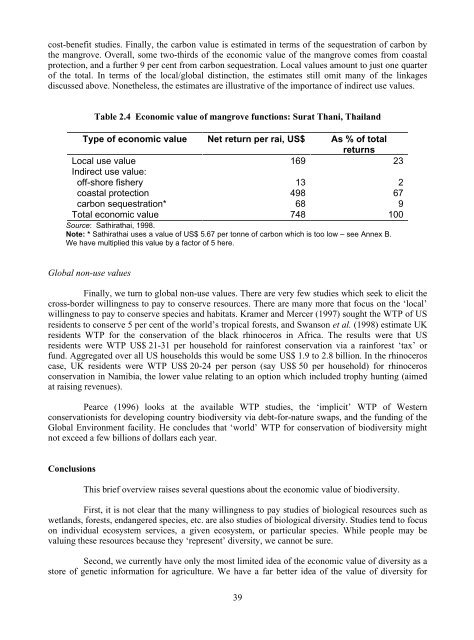Valuation of Biodiversity Benefits (OECD)
Valuation of Biodiversity Benefits (OECD)
Valuation of Biodiversity Benefits (OECD)
- No tags were found...
You also want an ePaper? Increase the reach of your titles
YUMPU automatically turns print PDFs into web optimized ePapers that Google loves.
cost-benefit studies. Finally, the carbon value is estimated in terms <strong>of</strong> the sequestration <strong>of</strong> carbon bythe mangrove. Overall, some two-thirds <strong>of</strong> the economic value <strong>of</strong> the mangrove comes from coastalprotection, and a further 9 per cent from carbon sequestration. Local values amount to just one quarter<strong>of</strong> the total. In terms <strong>of</strong> the local/global distinction, the estimates still omit many <strong>of</strong> the linkagesdiscussed above. Nonetheless, the estimates are illustrative <strong>of</strong> the importance <strong>of</strong> indirect use values.Table 2.4 Economic value <strong>of</strong> mangrove functions: Surat Thani, ThailandType <strong>of</strong> economic value Net return per rai, US$ As % <strong>of</strong> totalreturnsLocal use value 169 23Indirect use value:<strong>of</strong>f-shore fisherycoastal protectioncarbon sequestration*1349868Total economic value 748 100Source: Sathirathai, 1998.Note: * Sathirathai uses a value <strong>of</strong> US$ 5.67 per tonne <strong>of</strong> carbon which is too low – see Annex B.We have multiplied this value by a factor <strong>of</strong> 5 here.2679Global non-use valuesFinally, we turn to global non-use values. There are very few studies which seek to elicit thecross-border willingness to pay to conserve resources. There are many more that focus on the ‘local’willingness to pay to conserve species and habitats. Kramer and Mercer (1997) sought the WTP <strong>of</strong> USresidents to conserve 5 per cent <strong>of</strong> the world’s tropical forests, and Swanson et al. (1998) estimate UKresidents WTP for the conservation <strong>of</strong> the black rhinoceros in Africa. The results were that USresidents were WTP US$ 21-31 per household for rainforest conservation via a rainforest ‘tax’ orfund. Aggregated over all US households this would be some US$ 1.9 to 2.8 billion. In the rhinoceroscase, UK residents were WTP US$ 20-24 per person (say US$ 50 per household) for rhinocerosconservation in Namibia, the lower value relating to an option which included trophy hunting (aimedat raising revenues).Pearce (1996) looks at the available WTP studies, the ‘implicit’ WTP <strong>of</strong> Westernconservationists for developing country biodiversity via debt-for-nature swaps, and the funding <strong>of</strong> theGlobal Environment facility. He concludes that ‘world’ WTP for conservation <strong>of</strong> biodiversity mightnot exceed a few billions <strong>of</strong> dollars each year.ConclusionsThis brief overview raises several questions about the economic value <strong>of</strong> biodiversity.First, it is not clear that the many willingness to pay studies <strong>of</strong> biological resources such aswetlands, forests, endangered species, etc. are also studies <strong>of</strong> biological diversity. Studies tend to focuson individual ecosystem services, a given ecosystem, or particular species. While people may bevaluing these resources because they ‘represent’ diversity, we cannot be sure.Second, we currently have only the most limited idea <strong>of</strong> the economic value <strong>of</strong> diversity as astore <strong>of</strong> genetic information for agriculture. We have a far better idea <strong>of</strong> the value <strong>of</strong> diversity for39












